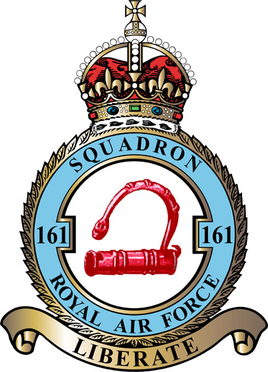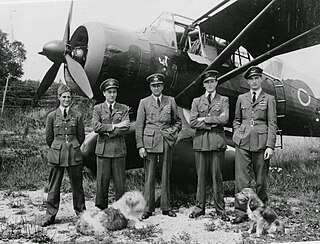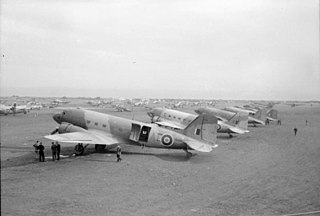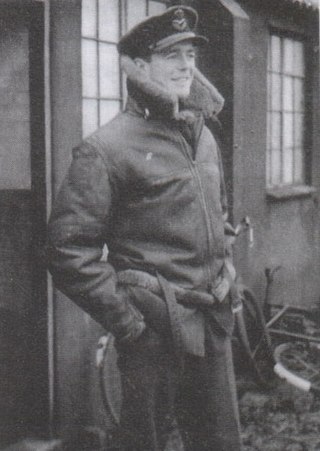Special Operations Executive (SOE) was a British organisation formed in 1940 to conduct espionage,sabotage and reconnaissance in German-occupied Europe and to aid local resistance movements during World War II.

The Westland Lysander is a British army co-operation and liaison aircraft produced by Westland Aircraft that was used immediately before and during the Second World War.

The Handley Page Halifax is a British Royal Air Force (RAF) four-engined heavy bomber of the Second World War. It was developed by Handley Page to the same specification as the contemporary twin-engine Avro Manchester.

Operation Freshman was the codename given to a British airborne operation conducted in November 1942 during World War II. It was the first British airborne operation using Airspeed Horsa gliders,and its target was the Vemork Norsk Hydro hydrogen electrolysis plant in Telemark,Norway which produced heavy water as a by-product.

Royal Air Force Tempsford or more simply RAF Tempsford is a former Royal Air Force station located 2.3 miles (3.7 km) north east of Sandy,Bedfordshire,England and 4.4 miles (7.1 km) south of St. Neots,Cambridgeshire,England.

Group Captain Percy Charles "Pick" Pickard,was an officer in the Royal Air Force during the Second World War. He served as a pilot and commander,and was the first officer of the RAF to be awarded the DSO three times during the war. He flew over a hundred sorties and distinguished himself in a variety of operations requiring coolness under fire.
RAF Ringway was a Royal Air Force satellite station at Ringway,Cheshire,England,near Manchester. It was operational from 1939 until 1957. The site is now occupied by Manchester Airport.

No. 138 Squadron RAF was a squadron of the Royal Air Force that served in a variety of roles during its career,last disbanded in 1962. It was the first 'V-bomber' squadron of the RAF,flying the Vickers Valiant between 1955 and 1962.

No. 161 Squadron was a highly secretive unit of the Royal Air Force,performing missions as part of the Royal Air Force Special Duties Service. It was tasked with missions of the Special Operations Executive (SOE) and the Secret Intelligence Service (SIS) during the Second World War. Their primary role was to drop and collect secret agents and equipment into and from Nazi-occupied Europe. The squadron had a secondary role in acting as the King's Flight,where it was responsible for transporting royal family members.

Air Vice-Marshal Sir Edward Hedley "Mouse" Fielden,was a senior Royal Air Force commander and a pilot of the Second World War.

Air Chief Marshal Sir Lewis Macdonald Hodges,was a pilot for Special Operations Executive (SOE) in the Second World War,and later achieved high command in the Royal Air Force and NATO.

The Free French Air Forces were the air arm of the Free French Forces in the Second World War,created by Charles de Gaulle in 1940. The designation ceased to exist in 1943 when the Free French Forces merged with General Giraud's forces. The name was still in common use however,until the liberation of France in 1944,when they became the French Air Army. Martial Henri Valin commanded them from 1941 to 1944,then stayed on to command the Air Army.

No. 466 Squadron RAAF was a Royal Australian Air Force (RAAF) bomber squadron during World War II. Formed in the United Kingdom in late 1942,the squadron undertook combat operations in Europe until the end of the war,flying heavy bomber aircraft. Following the conclusion of hostilities with Germany,the squadron began retraining to undertake operations in the Pacific against the Japanese,but the war came to an end before it left the UK. In late 1945,the squadron was disbanded.

Operation Paravane was a British air raid of World War II that inflicted heavy damage on the German battleship Tirpitz,at anchor in Kaafjord in the far north of German-occupied Norway. The attack was conducted on 15 September 1944 by 21 Royal Air Force heavy bombers,which flew from an airfield in the north of the Soviet Union. The battleship was struck by one bomb,and further damaged by several near misses. This damage rendered Tirpitz unfit for combat,and she could not be repaired as it was no longer possible for the Germans to sail her to a major port.

Hugh Verity,was a Royal Air Force fighter pilot and later a "special duties" squadron pilot working with the Special Operations Executive (SOE) during World War II. He landed many times at clandestine airfields in occupied France to insert and extract SOE agents. He was decorated for gallantry five times.

Royal Air Force Graveley or more simply RAF Graveley is a former Royal Air Force station located 5 miles (8 km) south of Huntingdon. The station was originally intended to operate under No. 3 Group RAF,alongside RAF Tempsford and RAF Gransden Lodge.

The Tempsford Memorial is a war memorial in the village of Tempsford in Bedfordshire. The village was the home of RAF Tempsford. The memorial commemorates the women who served as secret agents in occupied Europe during the Second World War,the RAF aircrew who transported them,and the personnel from allied secret services who were killed in the war. The memorial bears the names of 75 known women agents,of whom 29 were arrested,16 were executed,three died of illnesses while imprisoned,and one committed suicide using a cyanide L-pill before being captured.

James Atterby McCairns,was an English pilot with the Royal Air Force. He flew the Supermarine Spitfire fighter before becoming a prisoner of war,escaping and returning to England. He returned to active service as a "special duties" pilot working with Special Operations Executive,carrying agents to and from occupied France,before returning to combat in 1945 as a successful fighter pilot. He was decorated for gallantry five times and was killed in an air crash in 1948.

The Royal Air Force Special Duties (SD) Service was a secret air service created to provide air transport to support the resistance movement in Axis controlled territories. The service helped develop and support the resistance by bringing in agents,wireless operators and supplies. Parachute drop was the primary method by which the Special Duties units delivered supplies and most of the agents to the occupied countries. They also developed an air taxi service to pick up agents,political leaders and special communications from occupied Europe and bring them to England. On the outward flight the air taxi service also delivered agents and high value packages to France. Special Duties flights flew to target fields in Vichy France,Occupied France,Belgium,Netherlands,Norway,Poland,Czechoslovakia,Yugoslavia,and Greece. By the end of the war Special Duties units were also operating in the Far East. The air units were controlled by the Royal Air Force,and worked closely with the SOE and the SIS.

Peter Vaughan-Fowler,was an officer who served in the Royal Air Force. He is best known for his work as a "special duties" pilot,supporting the SOE and the SIS,carrying agents to and from occupied France.
















